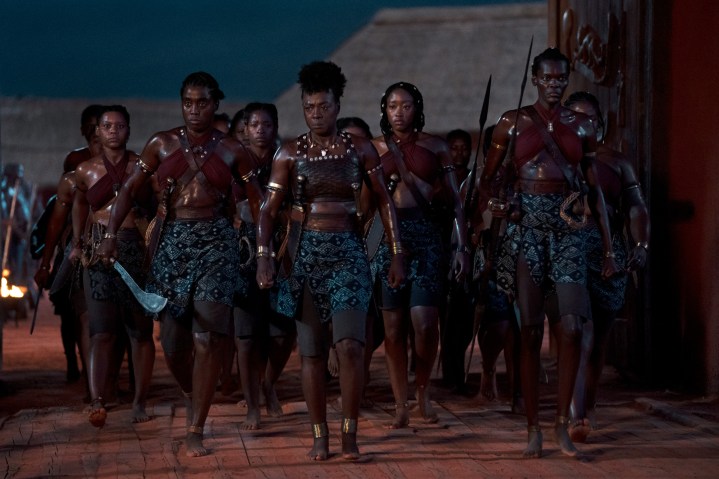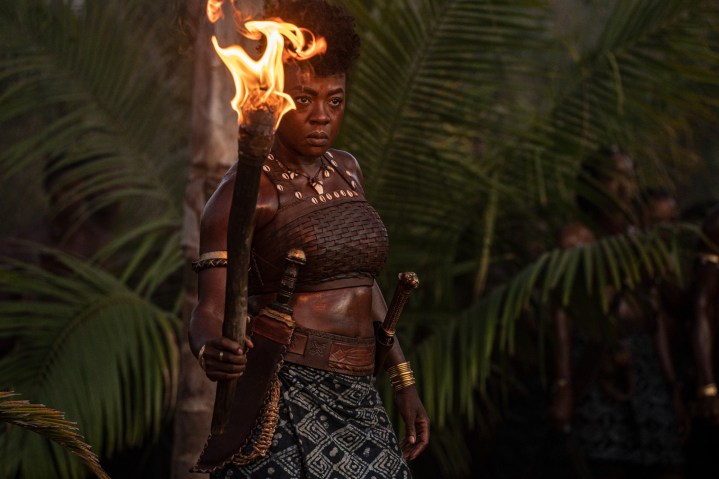The Woman King opens purposefully and violently. The film’s first sequence, which brings to life a brutal battle from its sudden beginning all the way to its somber end, is a master class in visual storytelling. Not only does it allow director Gina Prince-Bythewood to, once again, prove her worth as a capable action filmmaker, but it also introduces The Woman King’s central all-female army, sets up the film’s core conflict, and introduces nearly every important character that you’ll need to know for the two hours that follow it. The fact that The Woman King does all of this within the span of a few short minutes just makes its opening sequence all the more impressive.
The level of impressive craftsmanship in The Woman King’s memorably violent prologue is present throughout the entirety of its 135-minute runtime. For that reason, the film often feels like a throwback to an era that seems to reside farther in the past than it actually does, one when it was common for all the major Hollywood studios to regularly put out historical epics that were, if nothing else, reliably well-made and dramatically engaging.
Nowadays, those qualities feel increasingly hard to find in most contemporary blockbusters. The Woman King, thankfully, reminds us of what a midsized blockbuster can — and should — be. As the film’s director, Prince-Bythewood, who already ranks as one of Hollywood’s most underappreciated filmmakers, manages to do that while bringing to life a cinematic story that definitely wouldn’t have been produced 1o or 15 years ago.

Set in the early 1800s, The Woman King follows the Agojie, the all-female army that is assigned to protect the West African kingdom of Dahomey, as well as its ruler, King Ghezo (John Boyega). Led by the fierce General Nanisca (a reliably commanding Viola Davis), the film follows the Agojie as they lead Dahomey into a long-brewing conflict with the neighboring Oyo Empire after the latter attempts to increase its power over Dahomey by demanding that more of the kingdom’s citizens be sold into slavery.
The conflict between Dahomey and the Oyo Empire quickly turns out to be more personal for Davis’ Nanisca than she expected, but The Woman King spends most of its first half exploring the customs and friendships that bind the women of the Agojie together. The film does so by introducing Nawi (Thuso Mbedu), a young girl who proves to be so resistant to the very concept of arranged marriage that her father ends up offering her up to the Agojie as a new recruit. It’s through Nawi’s eyes that viewers are then drawn into the all-female world of the Agojie, which counts the formidable Izogie (Lashana Lynch) and the wise Amenza (Sheila Atim) as two of its high-ranking members.
But, as inspiring as the Agojie are, The Woman King doesn’t make the conflict between their kingdom of Dahomey and the Oyo Empire as clear-cut as it initially appears. Dahomey’s anger over the Oyo Empire’s engagement in the slave trade is, notably, complicated by the fact that it and its leaders have similarly accumulated great wealth by capturing and selling their fellow Africans into slavery. This fact weighs heavy on Davis’ Nanisca, and while the rivalry between Dahomey and the Oyo Empire is the source of The Woman King’s biggest action sequences and set pieces, it gradually becomes clear that the film’s villain is not the Oyo Empire, but the slave trade itself.

When The Woman King focuses on those aspects of its story, it’s often riveting. The same cannot be said for the moments when the film shifts its focus to superfluous subplots like the romance that develops between Mbedu’s Nawi and Malik (Jordan Bolger), a half-Dahomey, half-Portuguese man who arrives in Africa alongside Santo Ferreira (Hero Fiennes Tiffin), a friend whose family made their fortune through the slave trade. Malik and Nawi’s scenes carry neither the romantic spark nor the thematic weight that they need in order to feel justified, which makes the film’s focus on their relationship in its second half nothing more than mildly irritating.
Prince-Bythewood and Dana Stevens’ script also attempts to literalize the guilt and ancestral pain that The Woman King’s characters carry with them through a twist that, at first, seems to defy all logic. However, while the storyline that stems from it frequently pushes against the boundaries of believability, it does culminate in a long, steady shot of Davis near the end of The Woman King that makes the entire subplot feel, if only for a moment, completely worth it. Such is the power of Davis, a performer who is capable of bringing regality, strength, and warmth to any part she plays.
Outside of Davis, Sheila Atim also impresses with her warm and considerate performance as Amenza, Nanisca’s second-in-command and most trusted friend. Lashana Lynch, meanwhile, nearly steals The Woman King out from under her co-stars with her turn as Izogie, the humorous but commanding Agojie warrior who takes Nawi under her wing early on in the film’s first act. In case her scene-stealing performance in last year’s No Time to Die hadn’t already done so, Lynch’s turn in The Woman King proves, once and for all, that she’s one of Hollywood’s most exciting emerging talents.

Behind the camera, Prince-Bythewood brings a muscular, confident visual style to The Woman King, allowing its various action sequences to unfold cleanly without ever resorting to any cheap gimmicks or attention-grabbing camera tricks. The director, along with her cinematographer, Polly Morgan, also gives The Woman King a rich look that only further emphasizes its deep shades of brown, red, black, purple, and green. Unlike a number of other blockbusters that have been released this year, The Woman King’s ambitions never exceed its reach either, which is to say that the film is basically devoid of the kind of distractingly bad VFX shots that have become far too common as of late.
In its attempts to jam as much into its story as possible, The Woman King does end up emerging as a far more uneven film than it might have been had it kept its focus solely on the personal and political struggles of the Agojie. Shaving off some of its unnecessary detours would have, at the very least, let The Woman King avoid some of the pacing problems it experiences throughout its second and third acts. Nevertheless, the film’s flaws don’t take much away from its entertainment value, nor do they lessen the weight of its most impactful moments.
More than anything, by bringing her strong grasp of cinematic language to The Woman King’s story, Prince-Bythewood has crafted a film that feels refreshingly modern and old school at the same time. It’s not a film that’ll make you nostalgic for the days when period epics like it were a dime a dozen, but one that, instead, has the power to make you wonder what kind of movies audiences could see in the future were Hollywood to actually begin investing again in more projects like The Woman King.
The Woman King hits theaters on Friday, September 16.



